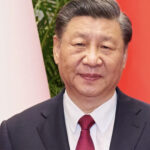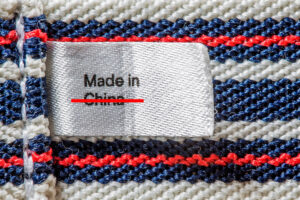As the pressure within the Chinese system continues to mount, you can expect to see signs as the first few things begin to crack. Those first pieces to slip will be manufactured goods, processed materials, and services.
The manufactured goods we all think of first are the consumer goods – aka all the crap that you use daily. Sure, we will face shortages on these things, but they can be replaced with time. The more critical side of manufactured goods are industrial components, like machinery and transformers. These will be harder to replace and are key to the reindustrialization that needs to take place in the US. Exports of processed materials like aluminum and lithium are dominated by China, and the US will face massive headaches if that goes offline. China’s lesser-known global tech role will erode if there were disruptions to hardware imports or further tightening of trade restrictions.
In a normal system, we would be able to see this collapse coming. However, thanks to Xi’s cult of personality, the rest of the world has a bag over its head and is in for a rude awakening.
Transcript
Hello. Peter Zeihan here coming to you from Arches National Park. Continuing on with the fire hose series, looking at China specifically, I thought it would be good to talk today about the things we need to look for as the Chinese system cracks apart under the strain. First up is manufactured goods.
Basically anything that’s assembled, but you can break this from our point of view, into two big categories. The things that we’re most likely to notice because they’re consumer products and those that are not on the consumer products. We’re gonna feel that now, the last vessel that was carrying, pre tariff shipments has already docked in Tacoma. Another one similar has already docked in Los Angeles. And Houston. Savannah and New York will get their last ones over the next 2 or 3 weeks.
So we’ll be seeing product shortages, start in the West Coast, moving to the Gulf Coast than the East Coast over the next three weeks, and they’ll basically cover the entire country within five weeks. So we’re going to have significant shortages of pretty much all of the day to day stuff that you’re used to getting. There is one exception there, and that is electronics because the, U.S. tech world was able to convince Trump to put an exception on things like, you know, iPhones and all that good stuff.
New tariffs are coming on. Those things just hasn’t happened yet. That’s a issue for another day. And while I say that this is, most noticeable, it’s probably the less important of the things that come out of the Chinese system from a manufactured goods point of view, because there are substitutes, they may cost more. It will take upwards of three years, for them to saturate the market the way that the Chinese products have and will take probably longer for the United States to make their own.
But most of these things aren’t mission critical. A much bigger issue is the more invisible products that are manufactured that do not go onto your shelves, but help the system run. This is really machinery is going to be the biggest category. If you’re going to build out your own industrial plant, you have to build the things that allow you to make the things.
And while the United States is the world’s largest producer of machinery overall, if you’re going to double the size of the industrial plant in a short period of time, we would basically need to see Houston do three and four times the amount that it’s doing already. That just can’t happen on anything less than a 5 to 10 year time frame.
Some product in there that you are really, really going to notice. Is anything in the electrical space, most notably transformers. The Chinese are the world’s largest exporter of transformers, typically at the low end. But you know, if you need the power grid to expand. None of this works without that. So the US is in this weird the situation where the Trump administration has basically forced us into a very, very, very, very, very quick industrialization.
Plus, something that would normally take 10 to 20 years. We now have to do in 4 to 5. And that means expanding the grid by a minimum of 50% in three years, which I think is technically impossible. And now we have to do it without the stuff that was coming out of China. About the only bright spot on this particular subtopic is that with the tariffs at the moment in abeyance because of the short term deal that was recently struck in Geneva, those parts will start moving again.
But again, there’s going to be a three month lag before we can get any of it in, which means a three month lag before we can do any serious re industrialization.
Okay. Second topic. Processed materials, intermediate goods, aluminum, lithium, things like that. Chinese is the world’s largest producer of all of them. In many cases, controls the majority of the global market for exports. Now, I have no reason at the moment to think that any of this is in any meaningful danger. But it’s more of a warning.
The Chinese system was terminal before this trade war began. The trajectory has definitely steepened, and we need to start thinking about what a world without the Chinese inputs looks like. And that is one where we really just don’t have them on a global basis. And specifically here in the United States, where we’ve basically been giving out of that business for a very long time.
Similar situation in Europe, not quite as extensive, in the negative in Japan, but not far off, when that happens. And I don’t think that’s going to be this year. But when it does, we’re going to find ourselves in a lurch, because all the things that we need in order to build out, the industrial plant that we’re going to need post globalization, post Trump, whatever you want to call it, will be gone.
And we’ll have to start from scratch with almost nothing to work from. So when that happens, that is when the product shortages get severe. That is when the inflation gets like crazy. And that’s when the U.S. industrial experience goes from one of growth to one of stagnation on a secular basis until it’s fixed.
And finally services. Now this is another one of those that isn’t going to be very visible to Americans, but it is going to be visible on a global basis. China is not a services economy, but it still has a billion people. And that means it has a robust services to service its own needs. Really, all we see on the American side of things are, very, very visible exceptions like, say, TikTok.
But on a global basis, the Chinese provide a lot of the backbone technical services that make the developing world run, especially in the poorer states, most notably Africa. So while the United States has Apple and Microsoft and Meta and all the rest, the Chinese have their own ecosystem. And that ecosystem dominates a lot of the international space. What the Chinese cannot do is keep it running in a trade war, because the Chinese are wholly dependent upon the hardware that is imported from the rest of the world, especially the high end stuff that allows them to make low and mid grade semiconductors with some degree of foreign involvement.
Now, the Chinese have made exemptions to their tariff policies so they can keep importing that stuff, which is primarily coming from the United States. But it’s only a matter of time before someone as prickly and transactional as Donald Trump ends those exports completely. And at that point, you’ll see a not so slow degradation in the ability of the Chinese to service their own population as well as everyone else’s.
Unfortunately, we’re not going to be able to anticipate any of these breaks until they actually happen. Part of the deal with Chairman G’s cult personality is he’s shot the messenger so many times at the bureaucracy when they come across some data that they don’t think their boss is going to like. It’s not that they collect it and just don’t share it with them.
They just stop collecting it. So we don’t have good death data. We don’t have good employment laid out by province or by sector. We don’t have information on land sales, which is the primary method that local governments use to raise, funds. We don’t have good agricultural production data because, you know, if it goes bad one year, that looks bad.
So they just start collecting it. And so the government no longer has the core awareness that is necessary to help shape decisions. And for those of us on the outside, even independent efforts to generate information have been broken down. Most consulting firms in China have been closed down, especially the foreign ones. And people are basically left trying to kind of come up with a proxy.
So they look at to see what electricity generation looks like, to extrapolate what economic activity might be. And my personal favorite, they’re using gym memberships as a proxy for population numbers and for employment because unemployed people don’t go to the gym, apparently. Anyway, that sort of disconnect because of ideology and ego and cults as making it almost impossible for us to figure out what’s going on under the hood in China and everything that’s going on international affairs and everything with the Trump administration, everything with trade is simply pushing us closer and closer to the edge that we can’t even see anymore.








